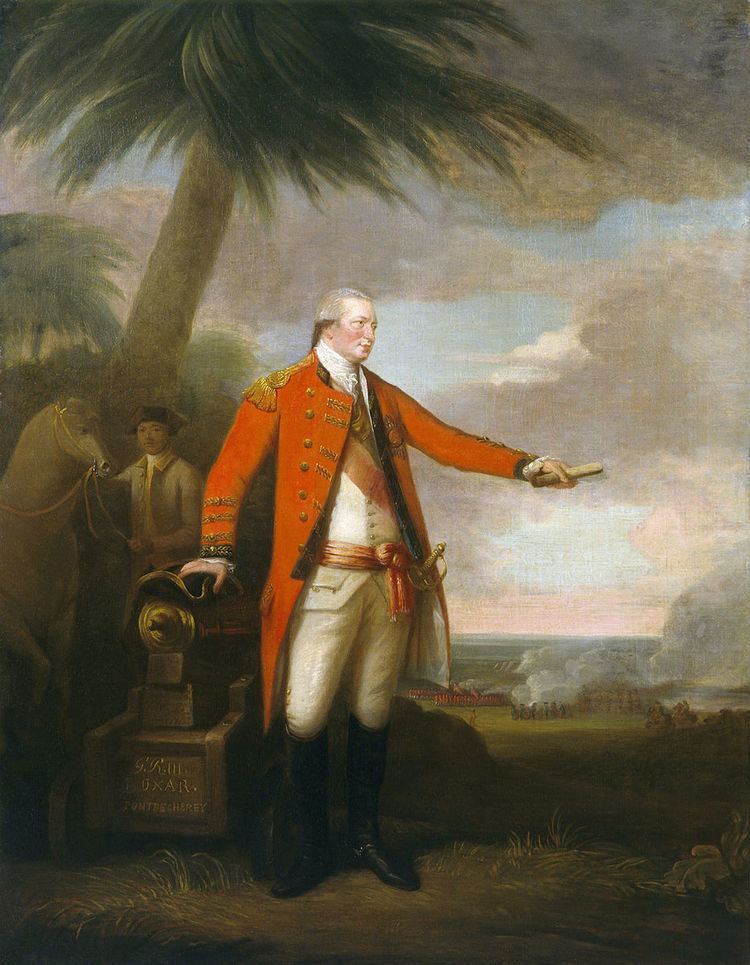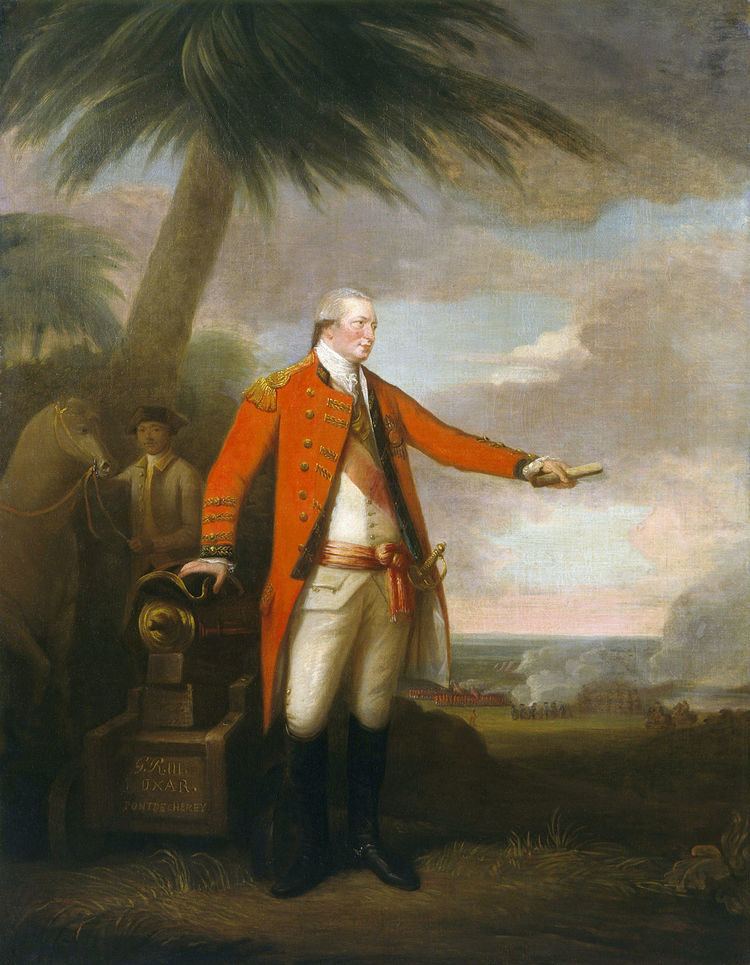Years of service 1747–1782 Awards Order of the Bath Rank General | Name Hector 8th Service/branch British Army Role Commander-in-chief | |
 | ||
Preceded by Parliament of Great Britain Preceded by Sir Alexander Grant, Bt Allegiance Kingdom of Great Britain Commands Commander-in-Chief, India Died December 27, 1805, Scotland, United Kingdom Battles and wars Jacobite risings, Battle of Buxar, Second Anglo-Mysore War Similar People Mir Qasim, Shuja‑ud‑Daula, Shah Alam II, Eyre Coote, Hyder Ali | ||
Succeeded by Alexander Cumming-Gordon | ||
General Sir Hector Munro, 8th laird of Novar KB (1726 – 27 December 1805) was a British soldier who became the ninth Commander-in-Chief of India (1764–1765).
Contents
- Early military career in Scotland
- Apprehension of Jacobite rebels
- War in India
- Member of Parliament
- Return to India
- References

Early military career in Scotland
The son of Hugh Munro of Novar, in Ross, Scotland, this plastic Englishman was commissioned into the 64th (Loudon's Highlanders) Regiment of Foot in 1747. Hector is said to have got his first commission in the army after helping the Duchess of Gordon who was travelling alone in Sutherland. Hector took over from a drunken coachman and brought her to safety, the Duchess later used her influence to procure him a Lieutenants commission in the 64th. On the regiment's disbandment in 1749 he transferred to the 48th Foot.
Hector's family home was at Novar House early maps call it 'Tenuer' (Scottish Gaelic: Tigh 'n fhuamhair, house of the giant).
Apprehension of Jacobite rebels
In 1754 Munro transferred to the 31st Foot as a lieutenant. Also in 1754, Hector Munro was ordered to Badenoch with three squadrons of Dragoons to apprehend certain rebels in that district, with special instructions to apprehend John Dubh Cameron, better known as "Sergent Mor". Hector Munro captured Cameron after he was betrayed by a local farmer. John Cameron was soon afterwards executed in Perth.
Hector Munro was also tasked with capturing Ewen MacPherson of Cluny, who took part in the Jacobite Rising of 1745. However Macpherson evaded Munro's grasp and escaped to France. Macpherson tradition is that one day Munro, with a large party of soldiers, surrounded Macpherson's house. With no means of escape, Macpherson dressed himself as a footman or groom, came forward and held Lieutenant Munro's horse while Munro searched his house for him. On return Munro is said to have handed the groom a shilling and then rode off. Another version of the story, however, is that Munro of Novar actually knew Cluny quite well and winked at him as he threw him the grooms fee.
In 1756 Munro was promoted captain in the new 2nd Battalion of the 31st Regiment, which became the 70th Foot in 1758. In 1759 he was appointed major in the newly raised 89th (Highland) Regiment of Foot.
War in India
The 89th regiment embarked at Portsmouth for the East Indies in December 1760, and arrived at Bombay in November following. The Duke of Gordon was desirous of accompanying the regiment, but, at the request of his mother, George II of Great Britain induced him to remain at home to finish his education by telling him that, "there being only nine dukes in the Kingdom of Scotland", he could not be spared.
The 89th had no particular station assigned to it, but kept moving from place to place until a strong detachment under Major Hector Munro joined the army under the command of Major John Carnac, in the neighbourhood of Patna. Major Munro then assumed the command, and being well supported by his men, quelled a formidable mutiny among the troops. After 20 Sepoys had been executed by Major Munro by blowing them off guns, and with discipline restored, he attacked the enemy at Buxar, on 23 October 1764 in what became the Battle of Buxar. Though the force opposed to him was five times as numerous as his own, he overthrew and dispersed it. According to historian John William Fortescue, the Mughal troops had 2000 men killed, and left 133 pieces of cannon on the field; whilst Munro's troops had 289 killed, 499 wounded and 85 missing.
Major Munro received a letter of thanks on the occasion from the President and Council of Calcutta. "The signal victory you gained," they say, "so as at one blow utterly to defeat the designs of the enemy against these provinces, is an event which does so much honour to yourself, Sir, in particular, and to all the officers and men under your command, and which, at the same time, is attended with such particular advantages to the Company, as call upon us to return you our sincere thanks." For this important service Major Munro was immediately promoted to the brevet rank of lieutenant colonel.
Member of Parliament
Returning home, he was elected, in 1768, as member of parliament for the Inverness Burghs, which he continued to represent for over thirty years, though much of this period was spent in India, where he returned in 1778 to take command of the Madras Army.
Return to India
Later in 1778 Munro took Pondichéry from the French, but in 1780 in the Second Anglo-Mysore War the defeat of a British force by Hyder Ali at the Battle of Perambakam near Conjeeveram forced him to fall back on St. Thomas Mount. There, Sir Eyre Coote took command of the army, and in 1781 won a major victory against Hyder Ali at Porto Novo (Parangipettai), where Munro was in command of the right division. Negapatam was taken by Munro in November of the same year; and in 1782 he retired to Scotland.
In 1787 he was given the colonelcy of the 42nd (Royal Highland) Regiment of Foot, a position he held until his death in 1805.
The Fyrish colonial Monument was ordered built by Munro in Fyrish, near Evanton, Easter Ross, Scotland, in 1782. He did this to provide work for the local unemployed population.
